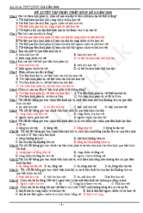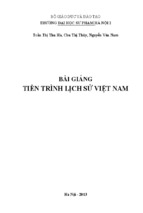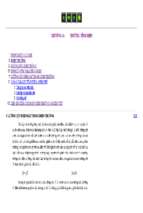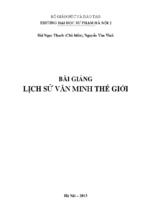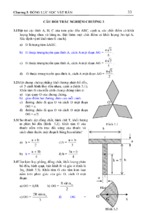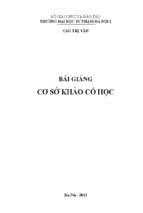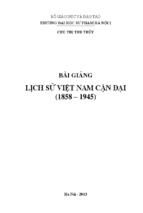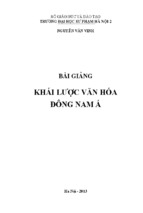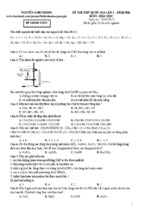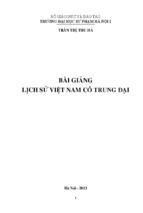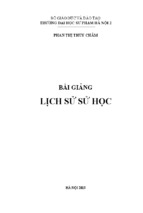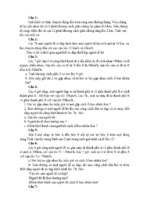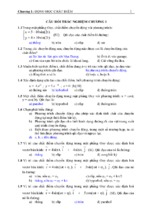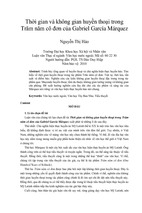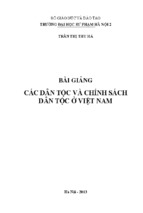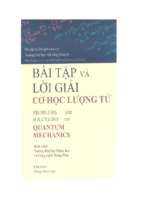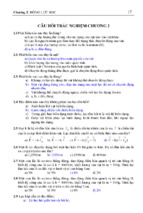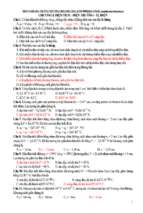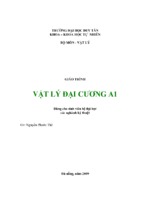sach về tesla và các phát minh của ông
RADIO DEPARTMENT
Th n Inltlt u h of E lectrical En g lnee ...
Hertz.-wave theory, by il$ fascinating hold
Wllh th e H Igh F l"1Iquency Altern"or Sho ..... n
on the imagination, has stifled creative efIn Fig. t. F Ig. 2.
fo rt in the wireless art and retarded it for
E lect r Ic Tr:tns m lulo n T h ru II S In g le WI,..
twcntr-five :rears. But, on the ot her hand,
Hydraulic An .log. F Ig. 4.
to those o f the Ge r man physicist. All my
it is ImpoSSIble to over-estimate the benerevious effort, with Rhumkorf (Oils had
ficial effects of the powerful stimulus it was the initial !te~ in the evolution o f illY
e ft me unconvinced, and in order to sethas given in ma ny directions.
wirele5s system. The idea preSented itself
tle my doubts 1 wenl over the whole ground
once more, very carefully, with thcse imAs regards signaling without wires, the to me that it might be possible. under ob-
I
---:J-
Jec_~
r.
~~I;r=;
--
May, 19 19
ELECTRICAL EXPERIMENTER
"w
IUultratlng T ypica l Arrlngemenu for
CoUectlng E nergy In a SYlum Of Trlnl _
ml .. lo n T hru a Sl ngl " Wire. Fig. 5.
servance o f proper conditions of resonance,
to transmit electric energy thru the earth,
th us dispensing with all artificial conductors.
Anyone who might wish to examine ilnpartially the me rit of that earlr suggestion
must not "iew it in the light 0 present day
science. I only need to say that as late as
1893, when I had prepared an elabdr.ue chapter on my wireless system. dwelling on its
various instrumentalities and future prospects, Mr. Joseph Wetzler and other friends
of mine emphatically proteSied against its
publication on the ground that such idle and
far-fetched speculations would ~n)ure me in
the opinion of conservative busmcn men.
So it came that only a small part of what
I had intended to say was embodied in my
address of that year before th e Franklin
Institute and National Electric Liltht Association under the chapter "On Electrical
ct a grlm E lu cida t Ing Eff"ct of Ll rge Capac_
Ity on On e En d. Fig . 5.
29
numbe r of radial improvements_ Suitable
high frequency generators and dcctricaJ oscillators had first to be prod~ The
energy of these had to be transformed in
effcct i n~_ transmitters and collcct«l at a
distance in proper receivers. Such a system would be manifestly cin:umscriJed m
its usefulnus if all extraneous inlttiuence were: nOt prevented and excJu!; ~
secured. In time, however. 1 recognUed
that devices of this kind, to be most ~«1£Jnvkd",poci~
£leO'CfaJ~~
. 1~~,; F.: ;:I-,;,.,.r
,. ,~.1lih" , .."""),!k"'~d'
Tr ~n.ml .. lo n Of E lec t rical Energy T hru th"
Eart h a. IIlu lt r~ted In Tnla'i Lecture. B".
fore the Franl(lIn Inltltute and E I"ct riC L ight
Associa t ion In F'bru~rl and March. 1893. and
Mec h anical Analog 0 th e Same.
FI~. 7.
ive and efficient. should be de:signed with
due regard to the physical propertin of
this planet and t he electrical conditions
obtaininc on the: same. I will briefly touch
upon the salient ad"ances as they ....ere
made in the gradual deve:lopment of the
system.
The high frequency alterllato r employed
in my first dellionstrations is illustrated in
Fig. 1. It comprised a field ring, with 384
pole projections and a d isc armature with
coils wound in one single layer which were:
connected in va rious ways according to requirements. It was an excellent machine
for experimcntal purposes, furnishing sinusoidal currents of from IO,OClO to 20,000
cycles per s.econd, The output was comparatively large, due to the fact that as
much as 30 amperes per SQuare millimeter
could be past thru the coils without injury.
The diag ram in Fig. 2 sh ows the circuit
a rrangeme:I\IS as used ill my lecture. Resonant conditions were maintained by means
Ta 'a's Sya-tem of W lrelen T ranlmlnlo'"
Th", th. Earth as Actually Exposed In
H I, Lacturet Befor-e th e Frankli n In_
Itltute Ind Electric Light "'"oclatlon In
February and Mlrch, 1893, F ig."
of a condenser subdidded into small sec·
tions. the finer adju5tmrots being dlected
by a movable iron core: within an indllct·
ance coil. Loosely linked with the latter
was a high tension scocmdary which was
tuned to the primary.
The operation of devicC$
wire without return was punl;,!"
because of its novelty,
explained by suitabJi!,:_ ,:",.",Iii;~
purpose refere nce ';s
I n the former the I
cond uctors are
¥ii¥
...
e"
Tho Fore runne r of
Audlon - the
Se n sit iv e
Wlteletl
Detector
Kn ow n. ae Oe ·
ICrlbed by T.I II In
HI , Lectu re Before
th. Inltltutlon Of
E lec tri cal En gl.
n. a r l. London,
Februar y, 1892.
Fi g. II.
seclion, th e alternator by an oscillating
Resonance." This little salvage from the
piston and the filament of an incandescent
wreck has earned me the title of "Father
lamp by a minute channel connecting the
of the Wire:Jess" from many well-disposed
pi pes. It will be clear from a glance at
fellow workers, rather than the invention
the diagram that "ery slight excursions
of Kores of appliances which bave brought
of the piston would cause the fluid to rush
wireless transwith high vemission within
locity thru the
the reach of
small channel
every young
and that vir·
amateur a n d
tually all the
ene r gy of
which. >in a
time not dismovement
tant, will lead
w ou ld
be
to undertakt r a IIsfonned
ings overshad·
into heat by
owing in magfriction, simi_
nitude and
larly to that
importance all
of the electric
past achievecurrent in the
lamp filament.
menu of the
The second
engineer.
The popular
diagram will
impression is
now be selfthat my wire·
ex]) lanalory,
A,(y ar €U"aPI r
M>d
like those of
"'Q_ ..........piston osciltoday. It was
lales the bag
elear to me
expands and
from the very
Contra cts, and
~ ",bNr~
start that the
the fluid is
successful
made 10 surge
'11. 10.
con summathru the retion could only
stricted pasbe
brought Tn la 's Syllem of Co n ca tenate.f T uned Clrcultl Shown ~nd Described tn U. S. P atent No. 568.178 of sagewithgre:at
speed, thi.", _ __
about by a
S"ptember 22. 1896, ard ':orrespondlng ....... angementl In Wlrel ... Trantml,,'an,
01'1:'"
,,=,
" " " '"'"
t
_~
rc~uhing in the generation of he>t u in the
incandesccnt lamp. Thooreticalh- considered, the efficicllcy of conveulon of energy
should be the samc in both c",_es,
Gralllcd, then, that an economic system
of power transmission thr u a single wire is
,.
,
Tcsm four~JI''Cutf
tu"ui _,-deu SJU~
lions of the oscil lator might be modified
tbm the 'immense extem of the globe the
principles involved arc the same.
Consider now the effect of such a conductor of vast dimellsiOlls on a circuit exciting it. The upper diagram of Fig. 6 illustrates a familiar oscillating: liystem comprising a slr.light rod of sclf-mductancc 2L
with small terminal capacities (( and a node
in the center. In the lower diagram of the
figure a large capacity C is auached to the
rod at one end with the result of shifting
the node to the right. thru a distance corres ponding to self-inductance X. As both
paru of the s}stem on either side of the
node vibrate at the sallie rate, v,c have c\·idemly, (L
X) c = (L _ X) C from
+
which X = L
•
J
,
F o ur Ctn;ult Tu ned Syltem Con_
W ith th e Contemporanlou , Hertz _
Walll Syltem,
F ig. 11.
practicable, the question arises how to col\Vith this
object attention is called to Fig. 5, in which
a co nducto r is sho\\ n excited by an osdllator jo!ne~ t? it alone end. Evidently, as
the penodlc Impulses pa n Ihru th e win~ ,
uifferellces of potential will be created along
th e same as we ll as at right ang les to il
in the surrounding medium and either of
these may be usefully applied. Thus at a,
a circuit comp r ising an inductance and (3padty is resonantly excited in the t ransverse, and at b, in the longitudinal sense.
At c, ener~,'y is collected in a circuit parallel
to Ihe conductor but not in contact wilh it,
and again at d, in a ci rcuit which is pa rtly
sun k into the conductor and may be, or
not, electrically connected to the same. It
is important to keep these typ ical dispositions in mind. for howel'er the distant aclett the energy in the receilers.
Arrangementl Qf D l re ~(I"e Clrc u1ts
Dncrlbed In Tnl a', U. S. Patent No.
613,8011 01 NOllember 8. 189l1, on
"Method of and Apparatul for Con_
lroiling Mech.nl l m o f Moving Vu.. II or Vehlclet." Fig. 12.
C-,
c+,
When th e ca-
pacily C becomes commen~urate to that of
the earth, X approximates L, in other
words, the noue is close to the ground conIlcction. The I'X(l(/ detr'millPliulI of ils
po.dlioll is f.'Uy imparl/lilt {" tilt (01, .. /(1tian of ct rloin 11"'(,.Ilrilll rlrctrical (llid
geodetic dala and I have devised spedaJ
means with this purpose in view.
~Iy original plan of transmitting energy
without wires is shown in the upjl('r diagram o f Fig. 7, while the lowe r one Dlmt rates its mechanical ana log, first publisht
in my article in the Ct'''''Jr~ A/IJ{jazillt' of
Jun e, 1900. An alternator, preferably of
high tension, has one of its terminals conneCled to the ground and the other to an
elevated capacrty and impresses its oscillations upon the earth. At a distanl point
a receiving circuit, likewise connected to
ground and to an elevated capacit)', collects
some of the energy and actuates a suitable
device. I suggested a multiplication of
such units in o rder to intensify the effects,
an idea which may yet prove \'aluable. In
the analog two tuning forks arc provided,
one at the sending and the other at the receiving station, each having attached to its
lowe r prong a piston fitting in a cylinder.
The two cylinders communicate with a
large elastic resen·oir filled with an incom-
JiI~S21i~,.
--',,-::" .
','''/ .'
/
---'-"-
'
k::W;::----·· ~~:>::~:\
f!li/I:!
11111',1,1
"'1"
•
"::i):!
-_."",,
. -'-- _.
"
'.. \\\\'.\\
-",.~
.,.:;....,-~4_
\\\ ..··'\;'1
' \ ' \'
1. 111.1'
...:...-~ .
au ;
0'
D iagram E xpol lng the Fail icy
th e G liding
Walle Th eory .1 P ropounded In Wlrel ..1
T ext B ookl.
Fig. 11.
pressible fluid. The vibr ations transmitted
to either of the tuning forks excite them
by resonance and, thru electrical contacts
or otherwise. bring about the desired result. This, I may say, was not a mere
mechanical illustratiOll, but a simple representation of my apparatus for submarine
si/{naling. perfected bf me in 1892, but not
appreciated at that time, altho more efficit'nt than the instruments now in use.
The electric diagram in Fig. 7, which
was reproduced from my lecture. was
meant only for the exposition of the principle. The i'rrangement. as I described it
in detail, is shown in Fig. 8. In this case
an alternator energizes the primary of a
transfonner, the high tension secondary of
which is connected to the ground and an
dented capacity and tuned to the imprest
oscillations. The receiving circuit consists
of an inductance connected to the f,:round
an d to an elevatcd terminal without brea k
and is resonantly responsive to the transmitted oscillations. A specific form of re·
cciving de"ice was not mentioned, but I
had in mind to transform the recei" ed cur·
rents and thus make their \'ohlme and tension suitable for any purpose, This, in
suustance, is the system of toda~ ;and I a!ll.
not awa re of a single auth entical~ instance of successful transmi,sion at eon5iderat~e distance hy different instrumen_
talities. It might, vcrhaps, not be clear to
\ql;....~ ,
...;<,\7:,>:'>-,"',,,
.-~-.::..-=:::.~~:,\ :,~?-::.-;t
/<~:;:;:?=
I
I
I
t
i'~~:::3-<~>"
v.',. ' " '
I ~ / ' --,.... Q "" .. " ' \ '
1,/,,-......::.:...
I
I
!1-4~ 4q n I , \ I
If",'1
I
I
I:
:
\\\
,'"
I
,
1.,-
'fCln
"
\
I
I
I
I
I
' i : ' !
'.\
I
I
!
Fig. H. D iagram E xplainIng th e Re_
lati on Between t he Effectille and the
Mea.u~d Curren t In the Antenna.
those who ha ve perused my first description of'thcse improvemcnts that, besides
making known new and efficient types of
appa ratus. r gave to the world a wire kss
system o f potentialities far beyond anything before conceived. I made explicit
Q
6
Ifufz (}Self/c/oI' of
grwl t!nO!I,Y IneH«''''f
Fig. 15. IIIUltraU ng One of the General E III _
dence. Aga ln . t the Space Walle Tranlm lulon.
and repeated statements that I contemplat~ transmission, absolutely unlimited as
to terrestrial distance and amount of en·
ergy. Bm, altho 1 have oveTC{Jme all obstacks which st'emcd in the beginning un·
surmountable and fowld elegant solutions
of all the problems which confronted me.
yet, e,'en at this very day, the majority of
experts are stiJI blind to the possibilitiu
which arc within easv attainment.
).Iy confidence that a signal could be
easily flashed a round the globe waS
strengthened thru the discovery of the " rotating brush." a wonderful phenomenon
which I have fully dcscri bed in my addreu
before the I nstitution of Electrical Engineers. London. in 1892, and which is illustrated in Fig. 9. T his is undoubtedly the
most delica te wireless detector known, but
for a lo ng time it was hard to produce and
to maintain in tht' sensitive state. These
difficulties do not exist now and I am looking to valua ble applicat'ions of this device,
particularly in connection with the highs~ed photographic method, which I suggested, in wireless, a~ well as in wire, transmission.
Possibly Ihe most important advances during the follow';ng three or four years were
my system of concatenated tuned ci rcuia
Fig. 16. Showlnll Un lmporUnce of Re l.;n·lle
Po.ltlon o f Tran.ml Uln g and Recellling An_
tennae In D llprollal of the Hertz·w.lve
Th eo ry.
and methods of r egulation, now univer_al_
adopted. The in timate bearing of th e"C :nl'C'ntions on the development of the wirele·
art will appear from Fig. 10, which illu-(COnl;'JUCd 0/1 page (1)
May, 19 19
The T rue Wireless
By Niko{fJ TU/fJ
(ColllilllUd from page 30)
tra tes an a rrangement des<:ribed in my U. S.
Patent No. 568178 of September 22, 1896,
and corresponding dispositions of wireless
apparatus. The captions of the individual
diagrams are thought sufficiently explicit to
dispense with further comment. I will
merely remark that in this early record. in
addition to indicating how any number of
resonant circuits may be linked and regulated, I ha"e shown the advantage of the
pro~r timing of primary impnlses and use
of ha r monics. In a farClcai wi reless suit in
London, some engineers. reckless of their
reputation, have claimed that my circuits
were not at all attuned; in fact they asserted that I had looked upon resonallce as
a sort of wild alld ull tamable beast!
It will be of interest to I;ompare my system as fin! deSl; ribed in a Belgian palent
of 1897 with the H ertz-wave system of that
period. The signifil;all t diffe rences between
them will be observed at a glance. The
firs t enables liS to transmit economically
energy to ally distance and is o f inestimable
value; the latte r is capable o f a radius of
ouly a few miles and is worthless. t n the
first there are no spark-gaps and the al;tions
are C'normously magnifiC'd by resonance. In
both transmitte r and recei"er the currents
are transformed an d rendered morc effecti,'e and suitable fo r the operation of any
desired de"ice. Properly constructed, my
system is safe against static and other interference and the amount of energy which
may be trans mitt cd is billiolu of Ii/lit:
greater than with the H ertzian which has
1I0ne of these \'irtues, has ne\'e r been used
successfully and of which no t race can be
found at prese nt.
A well-adve rt ised expe rt ga"e out a sta tement in 1899 that my apparatus d id not
work and tha t it would take 200 yea rs befo re a ml;ssage would be flashed across the
Atianl'iI; and he eve n accepted stolidly my
congratulations on a supposed great feat.
But subsequent exa mi na tion of the reco rds
showed tha t my devices were secrt'lly used
all the t ime and eve r since I learned o f this
I ha ve treated these Borgia-Medici methods
..... ith the contempt in ..... hich th ey arc held
by all fa ir-minded men. T he who lesal e
app ro pr ia~iOIl o f my inve ntions was, howeve r, no t al ways without a dive rt ing side.
A s an example 10 the point I may ment ion
my osciilalion transfonner operating wi th
an ai r ga p. T his was in tu rn re placed by
a carbon are, quenched ga p. an atmosp here
o f hydrogen. ar gon o r heliu m. by a mechanical break ..... ith oppositely rotat ing
members, a mer cury interrupter or some
kind of a vacuum bulb and by such tOllrs
de fo~(t as many ne w "systems" ha"e been
-produced. I refer to thlS of course. without the slightest ill-feeling, let us ad,'ance
by all tn('ans. But I cannot he lp thinking
how much bette r it would ha\'e been if the
ingenious men, ..... ho have originated these
"systems," had 4n\'emfii something of their
own instead of de~nding on me altogether.
Before 19(X) two mos t "aluable improvements were made. One of tbese was my
individualized system wilh tr.l nsmitters emitting a wave-.::omplex and recei\'e rs comprising s('parate tuned elements eoOperatn'el,y
associated. The unde rl ying principle can be
explained in a few words. Suppose that
there are II simple vibra tions swtable for
use in wireless tra nsmission, the probability that anyone tnne 'l\'ilI be str uck by an
1
extraneo us distu rbance is - . There will
"
then r emain 11-1 vibrations and the chance
1
that one of tlleSe will be excited is _ _ ,
II- I
hence the probability that two tune$ would
[
..E
be strllck at the same tim e is
. Sim/I ' 1I~1)
Harly, for a combina tion of three the chance
1
and so on. It will be
n ( n-I ) (11-2)
read ily seen that in this ma nner a ny desired
degree of safety against the sta tics o r other
kind of disturbance can be a tt ained provided the Te1:eiving apparatus is so designed
that its oper.ttioll is poss ible only Ihru the
joint aCiion of all the tutled elcmcnL. This
will be
was a difficult problem which I have successfully solved so that now auy desired
mUllb .. r of simultalli'ous messages is prac!icable in the Inmsmi.uioll IIrru the eorlh as
wi'll as thrrl artificial rOllductol's.
The othe r invention. of still g reater 1mpartance, is a peculiar o scillator enabling
the transmis sion of energy witho ut wire s
in any quantity that may ever be require!1
for illuustrial use, to any distance, and with
very hiGh economy. l t was the ou tcome
of years of systematic study and investigation and wonders will be achieved by its
means.
The prevailing misconception of the mechani sm involved in the wireless transmission has been resp-onsible for various
unwarranted ;lIlnO\lncements which ha ve
misled the public a nd worked hann. Bv
keerJing s teadily ill mind that the tran smi i~iun thru the earth is in every re spect
identical to that thm a s traight wire, o ne
will gain a clear understanding o f the pheno mella and wi!! be able to jud~e correctly
lhe meri ts of a new scheme. \Vlthout v."; shing to det ract from the value of any pla n
that has been put forwa rd 1 may say t hat
they a re devoid of llOvelty. So for ins tan ,e
in Fig. 12 arrangeme nts of tra nsmittin¥" and
re<: ei"ing circuits arc illustrated. whICh I
have described in my U. S. Patent No.
613809 of November 8, 1898 011 a 1lethod
of and Apparatus for ControUi.ng Mechanism of Mol'ing Vessels or Vehicles, and
which ha\'e been r ecently di s hed up as original discoveries. I n other pa ten ts a nd tet:hnica l publications I have suggested conductors in the ground as one of the: obvio\1~
modifications indicat ed in Fig. S.
F or the sa me reason the statics are slil1
die ba ne o f lhe wireless. There is aoout
as milch vi rtue in the remedies recenth'
proposed as in hair·restorers. A .mwll aud
compact apparatu.r has b.-nt prodl/crd which
does ·au'IlY eulir.-l" witlt tltis trouble at
least in plants smiably remodelJcd.
'
Xothi ng is mo re impo rtant in the present
!)hase of development of the wireless art
than to dispos e of the do minating erroneous
ideas. With this objcct I shal1 advance a
few a r~uments ha sed on my own observations which prm/{' Illal Hert:; ~MVI'S hovl!
little 10 do witlt the r ('sulls obtai lied 1!t.'CII
at S11l0/l disto.,,/!.!.
In Fig. 13 a transmitter is shown radia ting space waves of cO'lsiderabl e frequency.
It is general1), believed that these wave~
fI~sS alon g the earth' s surface and thus affect
tile receiv ers. I can hardly think of anything mo re improbable than this "gli ding
wave" theor}' and the conception of the
"guided wi.reless" which are contrary to all
laws of acti o n and reaction. \Vhy should
these disturbances cling to a conduclor
where thev are counteracted by induced currents, when they can propagate in all other
directions unimped ed? The fact is that the
radiations of the transmitter passing along
the earth's surface are soon exting uished.
Ihe height. of. the inactive zone indicated in
the diagram. bei ng some function of the
wave length. the bulk of the waves trave rsing freely the a tmosphe re. Terres t rial phenomena which I have noted conclusively
show tha t there is no Hta v isidr layer., or if
it exists, it is of no effect. It certain!)'
would be unfortunate if the human race
we re thus l Ilirp/oue
11'e ore merely working /hrll a cotldenur,
the capacity of which is a fun ction o f 3
IO,R'ar1thmic ratio between the length of the
conductor and the distance from the ~rO\lnd.
The receiver is affC(:led 1n t'xactly the !3me
manner as from an ordinary transmitter,
the only difference being tha t there ,s a cert ~i n modification of the- action which can be
predetermined f rom the electrical constants.
It is not at all difficult to maintain communication between an airplane and a
station on the ground, on tht' contrary, the
feat is vcry easy.'
To mention another experiment in support o f my view. I rna)' refer to Fig. 16 in
which twO grounded circuilS arc Showil
excited by oscillations of the Hert~ian order.
I! will be found that the antennas C;1Il be pm
0\11 o f paratlelism without noticeable change
iii the action on the recei" er, this prO\'il1'~
that it is duc to cnrrents propagated thru
. the grou nd and not to space waves.
Partkularly si!Zllifieant arc the r esults obtained in cases illustrated ;11 Figure~ 17 and
18. In the fonn er an obstacle is shown in
the path of the wave, but lmless the rc cciver is within thc effect ive t!ulroJllllir
influence o f th e mountain range. tbt" SiglHlls
arc 1I0t appreciably weakened by th e pre,·
ence of the latter, becanse the currents pass
I:nder it and excite thc circuit in Ihe same
way as if it were attached to an energized
wire. If. as in Fig. 18, a leeo nd ran J.!'e hap\>ens to be beyond the receiver. it could only
strengthen the Hertz wave eliect by re flec·
ti on, but a s a matter of fact it detrac ts
( C Oli/bUil d Oil pllge 87)
May, 1919
ELECTRICAL EXPERIMENTER
The True Wireless
By Niko/a 1'<1$1(1
(Coutillu arakd
'"
fmmgrovnd
ly spark gap
!'l
Such a mea sure, accordi ng to law,
>--.
=
§j
'3
~
§
S
§
1= isthereonl )'being
for the duration of the war,
at presen t
legislation
110
Fig. 19.
Comp"rlng t he Action . of T wo
Fo r m. of Tran smi tter a$ e earlng Out th e
Fallacy of the Hertz·wave Th eory .
observed from day 10 day lhe effect is
found to increase greatly wi th the dampness of the ground, and for the same reason
T"ransmi/fu"..ilfl small
terminal copoci!J
~
§
~
which preven B anI' slation, am ate ur or
~ o tlierwi5e, from ol,eraling after peace
h os actua ll y bee n declared. Th e refore,
tbe minute neWS llapen announce tllat
Ii:! p.eaee bet ..'een tile Un ited Stales and
~ the Central P oweu has been signed.
!j 6ft a",olellr s l<1li01lS /lulomatically r e = vert 10 II, e ir former slalus, and alllil'
teurs need not wait for Jler mi ssion to
operate the ir &t9 tioI15, once peace has
heen declared.
EDITOR.
I
~
~
~
~
-
E
iii
~
51
=
~
"'~
- Xem thêm -

